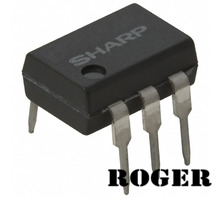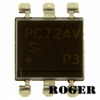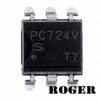
PC715V0NSZX
- Artikelnummer:
- PC715V0NSZX
- Hersteller:
- Sharp Microelectronics
- Beschreibung:
- OPTOISOLTR 5KV DARLINGTON 6-DIP
- RoHS-Status:
- Enthält Blei / RoHS nicht konform
- Menge auf Lager:
- 39460 Pieces
- Lieferzeit:
- 1-2 days (We have stocks to ship now)
- Produktionszeit:
- 4-8 weeks
- Datenblatt:
- PC715V0NSZX.pdf
Einführung
We can supply PC715V0NSZX, use the request quote form to request PC715V0NSZX pirce and lead time.XXX.com a professional electronic components distributor. With 3+ Million line items of available electronic components can ship in short lead-time, over 250 thousand part numbers of electronic components in stock for immediately delivery, which may include part number PC715V0NSZX.The price and lead time for PC715V0NSZX depending on the quantity required, availability and warehouse location.Contact us today and our sales representative will provide you price and delivery on Part# PC715V0NSZX.We look forward to working with you to establish long-term relations of cooperation
Spezifikation
| Interne Teilenummer | RO-PC715V0NSZX |
|---|---|
| Bedingung | Original New |
| Herkunftsland | Contact us |
| Top-Markierung | email us |
| Ersatz | See datasheet |
| Spannung - Ausgabe (max): | 35V |
| Spannung - Isolation: | 5000Vrms |
| Spannung - Vorwärts (Vf) (Typ): | 1.2V |
| VCE Sätttigung (max): | 1V |
| Ein- / Ausschaltzeit (Typ): | - |
| Supplier Device-Gehäuse: | 6-DIP |
| Serie: | - |
| Aufstieg / Fallzeit (Typ): | 60µs, 53µs |
| Verpackung: | Tube |
| Verpackung / Gehäuse: | 6-DIP (0.300", 7.62mm) |
| Ausgabetyp: | Darlington |
| Andere Namen: | 425-1420-5 |
| Betriebstemperatur: | -25°C ~ 100°C |
| Anzahl der Kanäle: | 1 |
| Befestigungsart: | Through Hole |
| Feuchtigkeitsempfindlichkeitsniveau (MSL): | 1 (Unlimited) |
| Bleifreier Status / RoHS-Status: | Contains lead / RoHS non-compliant |
| Eingabetyp: | DC |
| detaillierte Beschreibung: | Optoisolator Darlington Output 5000Vrms 1 Channel 6-DIP |
| Gleichstrom-Übertragungsverhältnis (min): | 600% @ 1mA |
| Stromübertragungsverhältnis (max): | 7500% @ 1mA |
| Strom - Ausgang / Kanal: | 80mA |
| Strom - DC Vorwärts (If) (Max): | 50mA |
| Email: | [email protected] |
läst Nachrichten
- Toshiba startet SmartMCD -Gate -Treiber IC mit eingebettetem Mikrocontroller
- ADI -Bereitstellung Sambanova -Kit, die die Produktionsformel AI fördert, um einen Durchbruch auf Unternehmensebene zu erzielen
- Honeywell und Adi haben sich den Händen angeschlossen, um die Innovation und den Wandel der Bauenautomatisierung zu fördern
- Maxim kündigte den Start an
- Maxim startet einen Auto-DC-DC-Konverter MAX16984, ein Auto mit integrierten USB-Ladeumzähern
- Renesas Electronics startet den ersten programmierbaren elektrischen Treiber der Branche IC
- Renesas startete die erste Generation von 32-Bit-RISC-V-CPU-Kernel
- Vishay startete die neue 10 -MBD -Leuchterkupplung mit niedriger Leistung von bis zu 5 mA, der Spannungsbereich beträgt 2,7 V bis 5,5 V.
- MELEXIS hat eine neue intelligente Lösung für die Integration zuverlässiger Sicherheit gestartet
- Toshiba hat das erste 2200V -Dual -Carbide -MOSFET -Modul der Branche entwickelt, um die effiziente und miniaturisierende Industriegeräte zu unterstützen
- Die DDR5 -Ära nähert sich und neue Herausforderungen können nicht ignoriert werden
- Renesas eröffnet die nächste Generation CAR SOC- und MCU -Prozessorproduktroutenkarte





